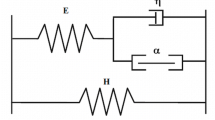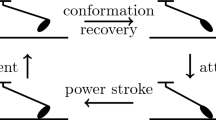Abstract
Huxley’s cross-bridge dynamics of muscle contraction is widely used in understanding, in particular, laboratory experiments on muscles and subunits of muscle. The hard-connection version of the model has several defects. In this paper I present a detailed and precise method of solution of the problem with a compliant element in series with the muscle.
Similar content being viewed by others
References
Bagni, M.A., Cecchi, G., Colombin, B., Colomo, F.: Sarcomere tension–stiffness relation during the tetanus rise in single frog muscle fibres. J. Muscle Res. Cell Motil. 20, 469–476 (1999)
Bagni, M.A., Cecchi, G., Colombini, B., Colomo, F.: A non-cross-bridge stiffness in activated frog muscle fibers. Biophys. J. 82, 3118–3127 (2002)
Bagni, M.A., Cecchi, G., Schoenberg, M.: A model of force production that explains the lag between crossbridge attachment and force after electrical stimulation of striated muscle fibers. Biophys. J. 54, 1105–1114 (1988)
Bennett, A.F.: Temperature and muscle. J. Exp. Biol. 115, 333–344 (1985)
Campbell, K.: Filament compliance effects can explain tension overshoots during force development. Biophys. J. 91, 4102–4109 (2006)
Cecchi, G., Griffiths, P.J., Taylor, S.: Muscular contraction: Kinetics of crossbridge attachment studied by high-frequency stiffness measurements. Science 217, 70–72 (1982)
Chase, P.B., Macpherson, J.M., Daniel, T.L.: A spatially explicit nanomechanical model of the half-sarcomere: Myofilament compliance affects ca2+-activation. Ann. Biomed. Eng. 32, 1559–1568 (2004)
Daniel, T.L., Trimble, A.C., Chase, P.B.: Compliant realignment of binding sites in muscle: Transient behavior and mechanical tuning. Biophys. J. 74, 1611–1621 (1998)
Duke, T.A.J.: Molecular model of muscle contraction. Proc. Natl. Acad. Sci. 96, 2770–2775 (1999)
Forcinito, M., Epstein, M., Herzog, W.: Theoretical considerations on myofibril stiffness. Biophys. J. 72, 1278–1286 (1997)
Fung, Y.C.: Biomechanics: Mechanical Properties of Living Tissues. Springer, New York (1993)
Goldman, Y.E., Huxley, A.F.: Actin compliance: are you pulling my chain? Biophys. J. 67, 2131–2133 (1994)
Hill, A.V.: The effect of series compliance on the tension developed in a muscle twitch. Proc. R. Soc. Lond. B 138, 325–329 (1951)
Hill, A.V.: The influence of temperature on the tension developed in an isometric twitch. Proc. R. Soc. Lond. B 138, 349–354 (1951)
Huxley, A.F.: Muscle structure and theories of contraction. Prog. Biophys. Biophys. Chem. 7, 255–318 (1957)
Huxley, A.F., Tideswell, S.: Filament compliance and tension transients in muscle. J. Muscle Res. Cell Motil. 17, 507–511 (1996)
Huxley, H.E., Stewart, A., Sosa, H., Irving, T.: X-ray diffraction measurements of the extensibility of actin and myosin filaments in contracting muscle. Biophys. J. 67, 2411–2421 (1994)
Julian, F.: Activation in a skeletal muscle contraction model with a modification for insect fibrillar muscle. Biophys. J. 9, 547–570 (1969)
Kawai, M., Halvorson, H.R.: Force transients and minimum cross-bridge models in muscular contraction. J. Muscle Res. Cell Motil. 28, 371–395 (2007)
Keener, J., Sneyd, N.: Mathematical Physiology. Springer, New York (1998). Chap. 18, pp. 542–578
Luo, Y., Cooke, R., Pate, E.: A model of stress relaxation in cross-bridge systems: effect of a series elastic element. Am. J. Physiol. 265, C279–C288 (1993)
Luo, Y., Cooke, R., Pate, E.: Effect of series elasticity on delay in development of tension relative to stiffness during muscle activation. Am. J. Physiol. 267, C1598–C1606 (1994)
Martyn, D., Chase, P., Regnier, M., Gordon, A.: A simple model with myofilament compliance predicts activation-dependent crossbridge kinetics in skinned skeletal fibers. Biophys. J. 83, 3425–3434 (2002)
Mijailovich, S., Fredberg, J., Butler, J.: On the theory of muscle contraction: filament extensibility and the development of isometric force and stiffness. Biophys. J. 71, 1475–1484 (1996)
Perreault, E.J., Day, S.J., Hulliger, Heckman, C.J., Sandercock, T.G.: Summation of forces from multiple motor units in the cat soleus muscle. J. Neurophysiol. 89, 738–744 (2003)
Proske, U., Morgan, D.L.: Do cross-bridges contribute to the tension during stretch of passive muscle? J. Muscle Res. Cell Motil. 20, 433–442 (1999)
Smith, D.A., Geeves, M.: Strain-dependent cross-bridge cycle for muscle. Biophys. J. 69, 524–537 (1995)
Smith, D.A., Geeves, M.A.: Strain-dependent cross-bridge cycle for muscle. II. Steady-state behavior. Biophys. J. 69, 538–552 (1995)
Smith, N.P., Barclay, C.J., Loiselle, D.S.: The efficiency of muscle contraction. Prog. Biophys. Mol. Biol. 88, 1–58 (2005)
Sugi, H., Kobayashi, T.: Sarcomere length and tension changes in tetanized frog muscle fibers after quick stretches and releases. Proc. Natl. Acad. Sci. 80, 6422–6425 (1983)
Thorson, J., White, D.C.S.: Distributed representations of actin-myosin interaction in the oscillatory contraction of muscle. Biophys. J. 9, 360–389 (1969)
Torelli, A.: Study of a mathematical model for muscle contraction with deformable elements. Rend. Semin. Mat. (Torino) 55, 241–271 (1997)
Wakabayashi, K., Sugimoto, Y., Tanaka, H., Ueno, Y., Takezawa, Y., Amemiya, Y.: X-ray diffraction evidence for the extensibility of actin and myosin filaments during muscle contraction. Biophys. J. 67, 2422–2435 (1994)
Wang, G., Ding, W., Kawai, M.: Does thin filament compliance diminish the cross-bridge kinetics? A study in rabbit psoas fibers. Biophys. J. 76, 978–984 (1999)
Zajac, F.E.: Muscle and tendon: properties, models, scaling, and applications to biometrics and motor control. Crit. Rev. Biomed. Eng. 17, 359–411 (1989)
Author information
Authors and Affiliations
Corresponding author
Rights and permissions
About this article
Cite this article
Williams, W.O. Huxley’s Model of Muscle Contraction with Compliance. J Elast 105, 365–380 (2011). https://doi.org/10.1007/s10659-011-9304-y
Received:
Published:
Issue Date:
DOI: https://doi.org/10.1007/s10659-011-9304-y




